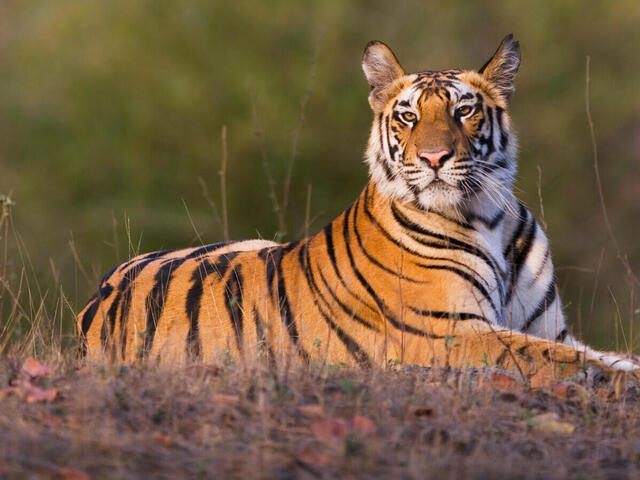Tigers are among the most iconic and majestic creatures in the animal kingdom. But have you ever wondered, what do tigers have that no other animals have? Their physical adaptations, unique characteristics, and ecological significance make them stand apart from every other species. In this article, we’ll delve into the distinctive traits of tigers, including their unique stripes, unparalleled adaptations, and their role in nature.

Tigers are renowned for their bold, black stripes that adorn their orange and white fur. What sets them apart from all other animals is the fact that:
Every tiger has a unique stripe pattern, much like human fingerprints. No two tigers have the same stripe arrangement.
Their stripes extend to their skin, which means that even if a tiger were shaved, its stripes would still be visible.
These stripes are not just for show. They serve as an effective camouflage in dense forests and tall grasslands, helping tigers blend into their surroundings to stalk prey.
Tigers possess several physical adaptations that make them apex predators:
Massive strength: Tigers are among the strongest big cats, capable of taking down prey much larger than themselves.
Unique hunting strategies: Unlike lions, which hunt in prides, tigers are solitary hunters. Their combination of stealth and power is unmatched in the wild.
Whisker sensitivity: Tigers have highly sensitive whiskers that help them navigate in the dark and sense their surroundings during a hunt.
A tiger’s roar can be heard up to two miles away, and it serves multiple purposes:
Territorial marking: Their roar warns other tigers to stay away.
Communication: It helps locate potential mates and signals danger.
Interestingly, tigers have a low-frequency growl that can resonate so deeply it causes vibrations, making it feel as much as it is heard—a trait not commonly found in other big cats.
Tigers' stripes are not just visually stunning; they are a vital adaptation for survival:
Camouflage in hunting: The vertical stripes break up their body outline, making them almost invisible in the shadows of dense forests or tall grass.
Protection from predators: For tiger cubs, their stripes help them remain hidden from potential threats while their mother hunts.
While cheetahs and leopards also have distinct patterns, their spots are vastly different from the stripes of tigers. Unlike tigers, these patterns do not extend to the skin, further highlighting the tiger’s uniqueness.
Tigers share some similarities with other members of the Panthera genus, like lions and leopards, but they have several distinct differences:
Hunting style: Tigers hunt alone, while lions work in groups.
Territorial behavior: Tigers are more territorial and rely on scent markings and roaring to claim their space.
Physical appearance: Unlike lions, tigers lack manes but are larger in size and possess the iconic striped pattern.
Tiger stripes are a result of genetic coding during embryonic development. Research has shown that specific genes regulate the formation of these patterns, making each tiger’s markings unique. These stripes are not just on the fur—they are embedded in the skin, an extraordinary trait that no other animal shares.
Born With Stripes: Tiger cubs are born with their stripes, and these patterns remain consistent throughout their lives.
Subspecies Variation: The Bengal tiger and Siberian tiger, for example, differ in stripe density and color tones, with Siberian tigers having lighter, sparser stripes.
Camouflage Masters: Tigers’ stripes are so effective that they can become almost invisible in their natural habitats.
Despite their incredible adaptations, tigers face numerous threats:
Habitat loss: Deforestation has significantly reduced their natural hunting grounds.
Poaching: Tigers are hunted for their skins, bones, and other body parts.
Human-wildlife conflict: As humans encroach on tiger territories, conflicts arise, often leading to the killing of tigers.
Conservation efforts are crucial to protect these magnificent creatures and their unique traits.
Tigers are not the only animals with remarkable features. Here’s a quick comparison:
Zebras: Known for their unique black-and-white stripes, but unlike tigers, these stripes don’t extend to their skin.
Cheetahs: Their spotted patterns are distinct but not as individualized as tiger stripes.
Snakes: Some species have striking patterns, but they lack the complexity and function of tiger stripes.
Yes, each tiger has a distinct stripe pattern that serves as a unique identifier.
The stripes on their skin are a genetic trait that mirrors the pattern on their fur, providing additional camouflage.
While lions, leopards, and cheetahs have distinct features, none share the same combination of characteristics that make tigers so unique.
Tigers possess several traits that set them apart from all other animals, with their one-of-a-kind stripes being the most iconic. These adaptations not only make them visually striking but also contribute to their survival in the wild. From their powerful roar to their unmatched hunting skills, tigers remain one of nature’s most fascinating predators.
By understanding and appreciating what makes tigers unique, we can better advocate for their conservation and ensure these magnificent creatures continue to thrive in the wild.
animal tags: tigers
We created this article in conjunction with AI technology, then made sure it was fact-checked and edited by a Animals Top editor.